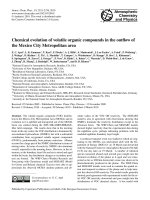Wireless Metropolitan Area Networks
Bạn đang xem bản rút gọn của tài liệu. Xem và tải ngay bản đầy đủ của tài liệu tại đây (306.42 KB, 21 trang )
Wireless Communications
Wireless Metropolitan Area
Networks
2
Objectives
•
Explain why wireless metropolitan area networks
(WMANs) are needed
•
Describe the components and modes of operation of
a WMAN
•
List the range of WMAN technologies, including FSO,
LMDS, MMDS, and 802.16 (WiMAX)
3
What is a WMAN?
•
Wireless metropolitan area networks (WMANs)
–
Provide wireless connectivity across a substantial
geographical area such as a large city
•
WMANs primary goals
–
Extend wired networks beyond a single location
•
Without the expense of high-speed cable-based
connections
–
Extend user mobility throughout a metropolitan area
–
Provide high-speed connections to areas not serviced
by any other method of connectivity
4
Last Mile Wired Connections
•
Last mile connection
–
Link between a customer and ISP
–
Most last mile connections use copper wiring
•
Copper-based digital communications lines
–
Require the signal to be regenerated every 6,000 feet
•
Last mile delivery of telephone and data lines has
long been a problem for the carrier
–
Must be able to justify the cost of installing wired
connections to remote areas
5
Last Mile Wired Connections
(continued)
6
Last Mile Wired Connections
(continued)
7
Last Mile Wireless Connections
•
Microwaves are higher frequency RF waves
–
In the 3 to 30 GHz range of the electromagnetic
spectrum known as super high frequency (SHF) band
•
Microwave towers are installed roughly 35 miles (56
kilometers) apart from each other
•
Fixed wireless
–
Wireless as the last mile connection for buildings
•
Backhaul connection
–
Company’s internal infrastructure connection
8
Free Space Optics
•
Free space optics (FSO)
–
Optical, wireless, point-to-point, line-
of-sight broadband technology
–
Excellent alternative to high-speed
fiber-optic cable
–
Can transmit up to 1.25 Gbps at a
distance of 4 miles (6.4 kilometers)
in full-duplex mode
–
Uses infrared (IR) transmission
instead of RF
•
Transmissions are sent by low-
powered invisible infrared beams
through the open air
–
FSO is a line-of-sight technology









